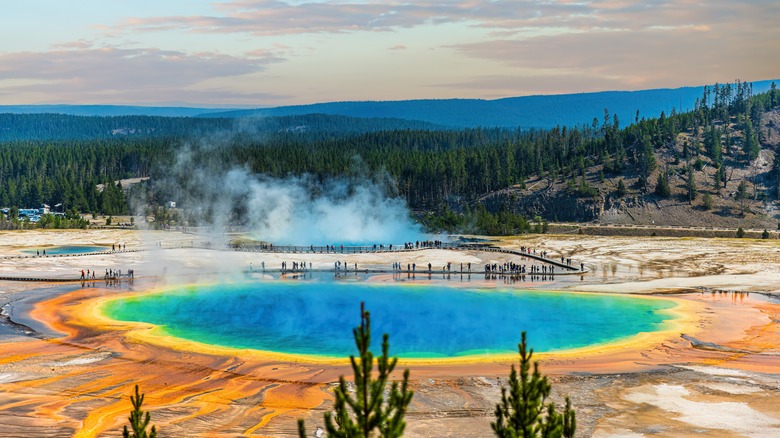Bubbling hot springs, abundant grizzly bears and bison, and the famous Old Faithful geyser are just some of the reasons Yellowstone National Park attracts roughly five million visitors every year. Is it possible to see Yellowstone in one day? Sort of. Yellowstone is larger than Rhode Island and Delaware combined, so fully experiencing the park requires a few days. But you can see many attractions in a single day’s drive, including Old Faithful, Grand Prismatic Spring, and the Grand Canyon of Yellowstone.
Established in 1872, Yellowstone was the world’s first national park. This wonderland of geothermal features is located mostly in Wyoming, but small bits extend into Montana and Idaho. Yellowstone has five main entrances. The west entrance, near the town of West Yellowstone, Montana, is the most popular entry point, so this guide primarily uses this entrance as the starting point, though we’ve also provided a few adjusted itineraries for those arriving at different entrances.
The park roads form two loops on top of each other, shaped like the number eight. While you could conceivably drive both loops in one day, doing so wouldn’t leave much time to get out of the car to enjoy the sights. We’ll focus mostly on the Lower Loop, where a majority of the park highlights can be found. Drawing from personal experience, with suggestions from the National Park Service, these recommendations are designed for those visiting from June to October, as most park roads are closed to motorized vehicles except snowmobiles in Yellowstone in winter and spring.
Gather everything you need to take into the park
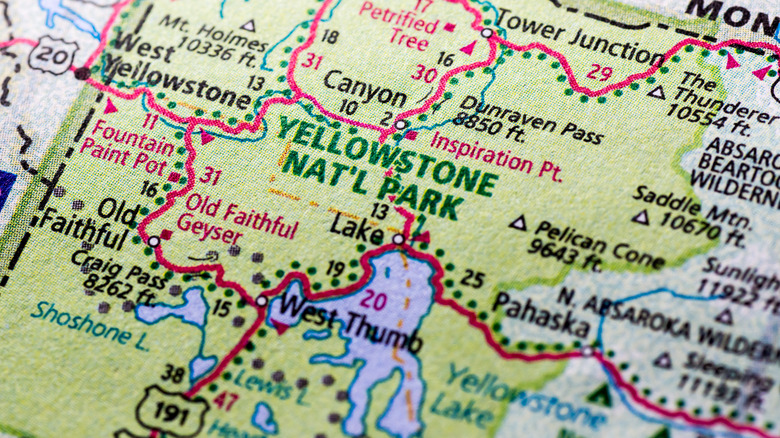
Yellowstone is a place where it’s essential to make some advance preparations before entering the park, especially with limited time. For example, although Yellowstone offers some dining options, it’s wise to gather up snacks and meals for the day. The park’s restaurants tend to be expensive and crowded, so you’re better off bringing sandwiches you can eat quickly while sitting in a picnic area.
Before entering the park, download park maps to your phone, since cell service is hit-or-miss throughout Yellowstone. Next, decide on your route. While this itinerary includes many of the park highlights, you can always make adjustments to suit your preferences. Visitors who are more into hiking and less into viewing hot springs may want to swap out a couple stops on this list for a longer hike at one of the trailheads.
Much of Yellowstone is above 8000 feet in elevation, so rain, wind, and snow can appear even in summer. Bring layers of clothing, including a knit hat and a rain jacket, to prepare for unpredictable weather. Bring bear spray as well if you plan to do any hikes into the backcountry. Finally, to maximize your one day in Yellowstone, be ready to head into the park as early as possible. In June and July, the sun rises before 6 a.m., so if you’re willing to leave your hotel around 5:30, you can beat the rush into the park and get 14 to 15 hours of daylight inside Yellowstone.
Firehole Lake Drive
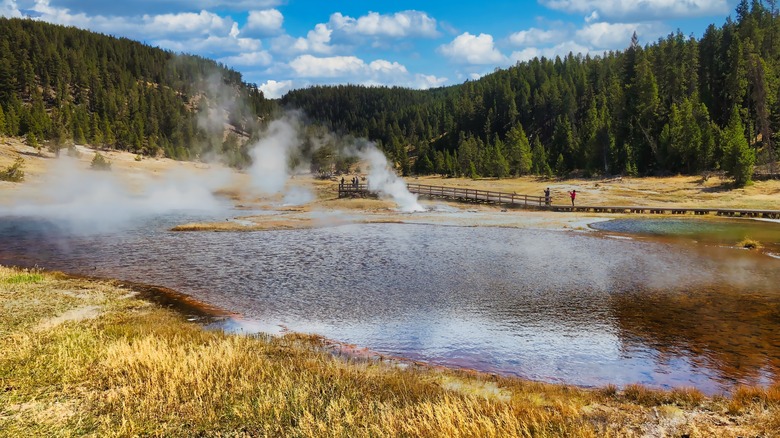
After entering the park via the West entrance, head down to Firehole Lake Drive. The three-mile loop road is about 45 minutes from the park entrance and passes by colorful hot springs and active geysers. This road features a boardwalk where you can get out and view Firehole Lake up close, surrounded by steaming vents that create a fog in the air. Great Fountain Geyser is one of the major highlights on Firehole Lake Drive. This geyser is one of the more impressive geothermal features in the park, but it only erupts once every 8 to 12 hours. Nearby White Dome Geyser offers a better chance to see a thermal water eruption, as its eruptions vary from 10 minutes to three hours apart.
Having only one day in Yellowstone means you probably won’t be able to make it up to Mammoth Hot Springs near the northern boundary of the park, but the many geysers, springs, and fumaroles on Firehole Lake Drive are a good substitute. Remember to always stay on the boardwalks when walking near geothermal features in Yellowstone. People have been seriously burned and even killed by walking off the path and falling through the thin crust of soil onto scalding water.
As a note, don’t confuse Firehole Lake Drive with Firehole Canyon Drive, which is another side road not far away. That road leads to a small waterfall and swimming hole but is probably worth skipping if you only have one day in Yellowstone.
Grand Prismatic Spring
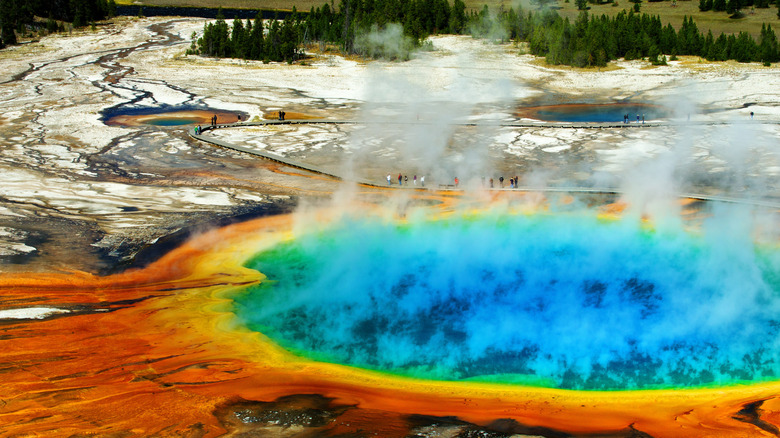
Lane V. Erickson/Shutterstock
Grand Prismatic Spring lives up to its name. At more than 120 feet deep and 370 feet wide at its widest point, according to the U.S. Geological Survey, Grand Prismatic is the largest hot spring in Yellowstone. It’s also one of the most photographed, thanks to its bright blue water and yellow and orange hues along the edges.
Grand Prismatic Spring is located in Midway Geyser Basin, which features a few other noteworthy spots, including Turquoise Pool, Opal Pool, and Excelsior Geyser Crater. You’ll pass them all on the short walk from the parking lot to Grand Prismatic Spring.
Consider walking the Grand Prismatic Overlook Trail, which starts from the Fairy Falls Trailhead and covers 1.5 miles round-trip. The walk only requires about 40 minutes and leads to a viewpoint looking over the spring. This may be your best bet for a short, scenic hike. Trying to squeeze Yellowstone into one day means there just won’t be time for many hiking opportunities.
Old Faithful
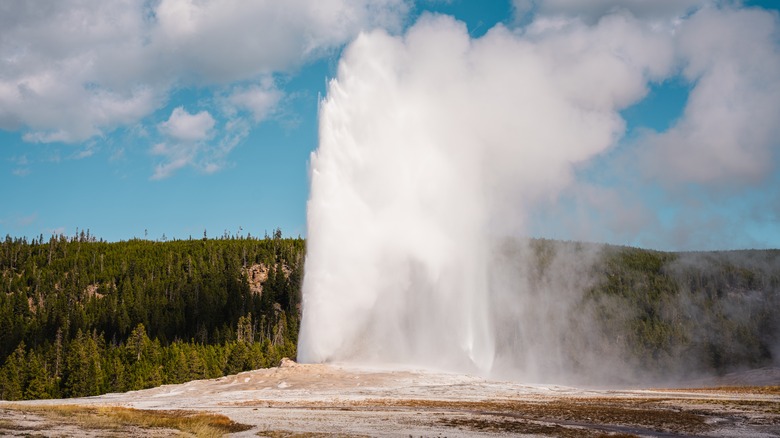
Mika Kaiser/Shutterstock
Just a short drive from Grand Prismatic Spring, your next stop could be Yellowstone’s most recognizable natural feature, the Old Faithful geyser. Old Faithful is one of the reasons Yellowstone is a bucket list destination for many. This landmark shoots thousands of gallons of water more than 100 feet in the air, with the typical eruption lasting a few minutes.
Those who stick to this itinerary should reach Old Faithful by 10 a.m., which should result in smaller crowds than those typically found later in the afternoon. The National Park Service says that Old Faithful eruptions take place between 68 and 94 minutes apart. Stop inside the Old Faithful Visitor Center when you arrive (or check the NPS app in advance) to see the next predicted eruption time.
Hopefully, luck will be on your side, and the geyser will be ready to put on a show shortly after you arrive. But if you end up with a lot of time to kill waiting for the next eruption, consider walking the 1.6-mile Observation Point Trail, which provides an elevated view of the Old Faithful area and Upper Geyser Basin.
Yellowstone Lake
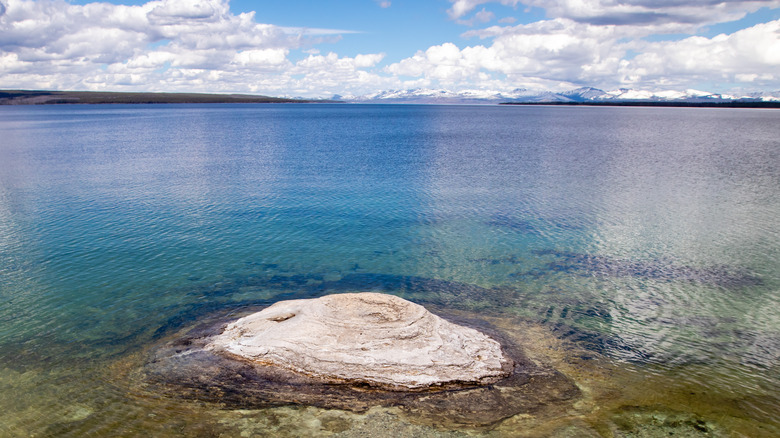
Michael Tatman/Shutterstock
Yellowstone Lake doesn’t seem to be as well-known as some of the park’s other features, but it’s one of the most striking attractions in the national park. The massive lake covers more than 130 square miles, making it the biggest lake above 7000 feet elevation on the continent. The park road hugs the lake for several miles, providing plenty of chances to pull over and see it up close.
West Thumb Geyser Basin on the far western end of the lake may be the ideal place to stop, since you’ll also be able to see the hydrothermal features right next to the lake. Walk the boardwalk at West Thumb to view roughly a dozen hot springs and pools. Lakeshore Geyser and the Fishing Cone hot spring are unique because they’re located right on the shore of the lake. Sometimes, they are submerged under lake water, and other times, they’re fully visible.
Boating and paddleboarding are permitted on Yellowstone Lake, but a license is required, and you’ll have to bring your vehicle and equipment, as there are no board or kayak rentals inside the park. The lake is impressive to see, but unless you plan on fishing or boating, there’s no particular reason to linger. View the geysers at West Thumb, take a few pics of the lake, and then continue heading north.
Hayden Valley
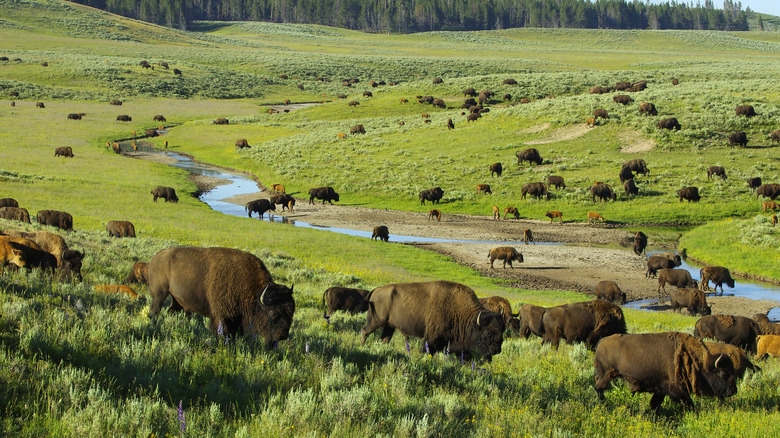
Jreden/Getty Images
Hayden Valley is a great place to see American bison in the summer. Driving through this valley near the Yellowstone River, you’ll likely encounter hundreds of bison on the fields next to the road and sometimes blocking the road itself. Don’t be surprised if you get stuck in a bison traffic jam, when cars are forced to wait patiently while the animals cross the road.
Bison nearly became extinct in the 1800s due to hunting, drought, and loss of habitat. The National Park Service notes that by 1894, Yellowstone was the only remaining place in the country with wild bison still roaming. Today, roughly 6000 bison live in Yellowstone, and they’ve become a symbol of the park and a conservation success story. Enjoy your views from a distance. The NPS encourages people to stay at least 100 feet away from bison. Though they may appear gentle, the animals can turn violent quickly when someone gets too close.
In the middle of Hayden Valley, you’ll find a parking area with a boardwalk leading to several highly active geothermal features with unusual names. The standout is Mud Volcano, a geyser that looks like a pool of bubbling muddy water. Sulphur Caldron, meanwhile, is exactly what it sounds like — a bubbling spring with a powerful sulfur smell. Other attractions you can walk to in this area include Grizzly Fumarole, Black Dragon’s Caldron, Sour Lake, Sizzling Basin, and Dragon’s Mouth Spring.
The Grand Canyon of Yellowstone
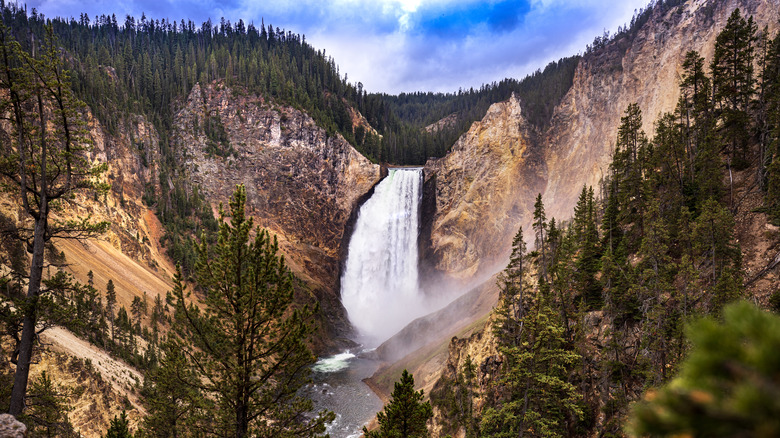
Nora Connors Photography/Shutterstock
Carved by the Yellowstone River, the Grand Canyon of Yellowstone is a must-visit natural feature. The Canyon is 24 miles long and about 1000 feet deep, and the ideal place to view it is from Canyon Village. This is one of the most memorable parts of the park, so take your time enjoying the area.
Explore North Rim Drive and South Rim Drive, both of which are only a few miles long and have lots of pullouts and parking lots along the way. Short walking trails take visitors to vantage points along the canyon’s edge. Walk to Lookout Point or Grand View along North Rim Drive for the best views of the water rushing through the canyon. Perhaps the most dramatic sections of the canyon are the two largest waterfalls: Upper Falls, which features a drop of 109 feet, and Lower Falls, which plunges 308 feet.
Inspiration Point doesn’t have the best views of the canyon’s interior, but it’s a good place to visit to fully appreciate the depth of the canyon. This point features a walkway extending partly into the gorge, where you can look up at the canyon wall on the other side.
Dunraven Pass
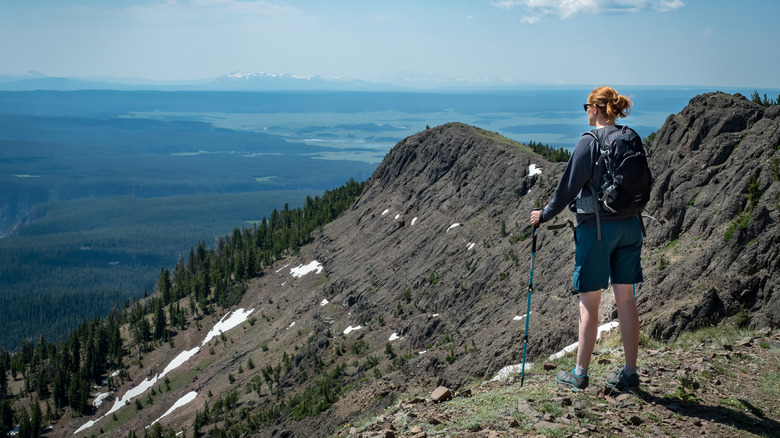
Kath Watson/Shutterstock
From the Grand Canyon of Yellowstone parking lots, the drive back to West Yellowstone is about one hour if traffic cooperates. Assuming there’s still plenty of daylight left in the day, drive north a bit to Dunraven Pass. At 8859 feet, Dunraven is the highest mountain pass in Yellowstone. The views of the surrounding valleys are outstanding, and grizzly bears are often spotted in this area. Park at the Mount Washburn Trailhead and hang out for a bit. This is a good spot to eat dinner, take in the sights, and see if any wildlife emerges.
In July and August, the Mount Washburn Trail is a great, moderately challenging hike that gets visitors away from the main park road and a bit into the Yellowstone backcountry. The full hike is nearly seven miles round-trip and features 1400 feet of elevation gain, but you can always walk a shorter portion of the trail without going all the way to the top. Keep an eye out for bighorn sheep as you move up the mountain, and be sure to carry bear spray and/or travel in a group. Note that rangers do not recommend hiking Mount Washburn in September or October, as grizzly activity greatly increases during that time when bears converge on the mountain to dig up pine nuts and moths.
Norris Geyser Basin
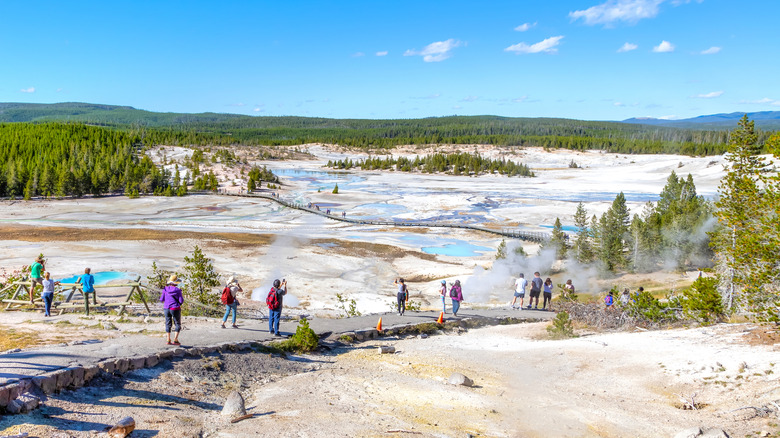
Ronnie Chua/Shutterstock
After Dunraven Pass, it will likely be time to start heading back toward your hotel. Along the way, make some final stops in the Norris Geyser Basin, the hottest and oldest geothermal area of the park. Considered the world’s tallest active geyser, Steamboat Geyser can spray up to 300 feet in the air, but it erupts infrequently. Steamboat usually goes many days between eruptions, and they cannot be predicted. Prior to 2018, Steamboat Geyser had only erupted a handful of times this century, according to the NPS. But starting in 2018, the geyser became more active. In the past few years, it has erupted between 7 and 48 times per year. Don’t count on seeing an eruption, but it’s still worth visiting, just in case.
Artists Paintpots is a one-mile loop in the basin that leads to mudpots and hot springs. Hikers on this trail can also see dead trees that remain from the devastating 1988 forest fires that burned 36% of the park. The Norris area also features two interesting museums, although both close before 5 p.m. The Museum of the National Park Ranger is housed in a former U.S. Army outpost from 1908 and tells the story of the history and responsibility of park rangers, while the Norris Geyser Basin Museum is a National Historic Landmark and offers interesting facts about the area. From Norris Geyser Basin, head back to West Yellowstone, and relax after a very long and hopefully memorable day in Yellowstone!
Itinerary for travelers coming from the South or East Entrance
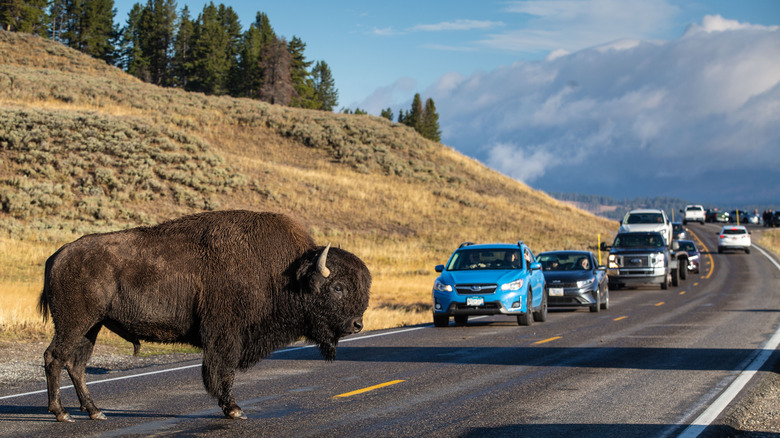
George Rose/Getty Images
If your day in Yellowstone is beginning from the park’s South or East Entrance, the recommended itinerary will be mostly the same, just in a different order. Yellowstone Lake will be the first major attraction you encounter. Continue to drive around the entire Lower Loop and hit each of the suggestions above.
Visitors using the South Entrance will be driving up from Grand Teton National Park, which lies only 30 miles south of Yellowstone and is a must-visit spot in Montana. The main points of interest on South Entrance Road are Lewis Lake and Lewis Falls, a modest, 30-foot waterfall with a roadside area to pull over and view the falls.
Entering Yellowstone through the East entrance from Cody, Wyoming, adds a couple more attractions to the schedule. Eleanor Lake and Sylvan Lake both have scenic picnic areas. Lake Butte Overlook is a one-mile spur road that leads to a remarkable viewpoint overlooking Yellowstone Lake with the Teton Mountains in the distance. Another benefit of coming in from the East Entrance is that you can drive through Hayden Valley in the early morning, when wildlife is more likely to be active.
Itinerary for travelers coming from the Northeast Entrance
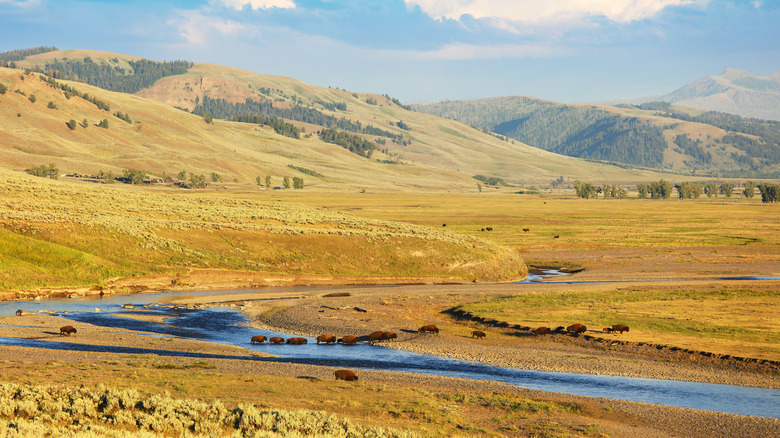
Jurgar/Getty Images
The Northeast Entrance from Cooke City, Montana, is on the complete opposite end of the park from Old Faithful and the rest of the Lower Loop. Therefore, folks coming in from the Northeast will have to skip many of the previous suggestions. Instead, visitors should stick to Yellowstone’s Upper Loop. On East Entrance Road, you’ll pass through Lamar Valley, a great place to see wildlife, including wolves. If you see a group of people with binoculars at a pullout on the side of the road, that’s a great time to get out of the car and find out what they’re looking at.
The Upper Loop also includes the Tower-Roosevelt area, home of the 132-foot-tall Tower Fall and the Petrified Tree, the stump of a 50 million-year-old fossilized redwood tree. After visiting these, move on to one of the major attractions on the Upper Loop (and the entire park), Mammoth Hot Springs. These springs feature impressive natural terraces composed of travertine, a chalky material formed when limestone reacts with thermal water.
After Mammoth Hot Springs, head back east and you should still have time to drive down to Dunraven Pass, the Grand Canyon of Yellowstone, and Hayden Valley. Old Faithful will likely be too far away to visit, unless you bypass most other attractions.
Itinerary for travelers coming from the Northwest Entrance
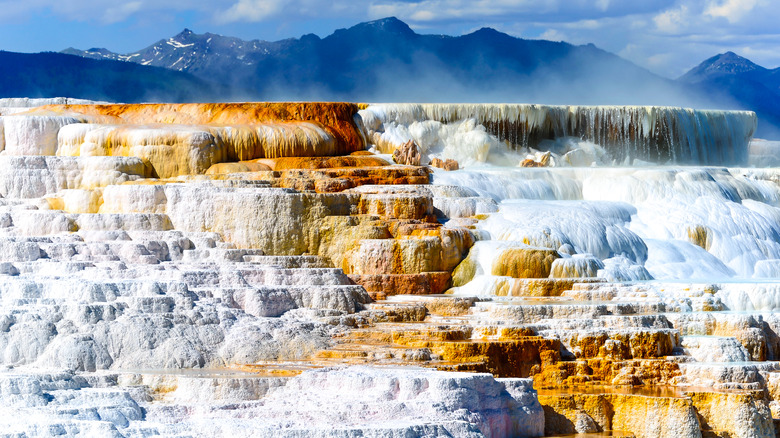
GJ-NYC/Shutterstock
The Northwest entrance near Gardiner, Montana, is commonly used by folks looking to visit Yellowstone on a budget. Hotels in Gardiner tend to be more affordable than park lodges, and the town is just outside the park boundary. If you’re coming from the Northwest Entrance for one day in Yellowstone, the first noteworthy spot is the park entrance itself, where Roosevelt Arch looms large over the road. President Theodore Roosevelt dedicated the arch in 1903. Today, it’s a historic landmark and one of the signature sights of the park.
It’s feasible to make it down to Old Faithful coming from the Northwest Entrance, but you may have to skip a few other stops. If you really want to see Old Faithful, go directly there from the Arch. Enjoy the eruption, and then head back north, making a stop at Grand Prismatic Spring before heading over to the Grand Canyon of Yellowstone.
From there, you can complete the Upper Loop in a counter-clockwise direction, stopping at Dunraven Pass and Tower Fall, if time permits. Save at least an hour to explore Mammoth Hot Springs on your way out of the park. If you prioritize the attractions you most want to see and exercise good time management, one day in Yellowstone will be sufficient to see a big chunk of the park.

